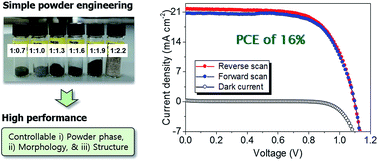Controlled growth of organic–inorganic hybrid CH3NH3PbI3 perovskite thin films from phase-controlled crystalline powders†
Abstract
High-quality CH3NH3PbI3 (MAPbI3) crystalline powders were synthesized from a dispersion of MAPbI3 solution (solvent: N,N-dimethylformamide (DMF)) in the antisolvent dichloromethane. They were used as starting chemicals for precursor solutions. The PbI2–DMF-, perovskite-, and PbI2–MAI (methylammonium iodide)–DMF-dominant phases were preferentially formed under conditions of excess PbI2, moderate, and high-excess MAI input ratios, respectively. The input ratio of powders in fabricating the thin MAPbI3 films strongly affected not only the morphology and structure of the films, but also the photovoltaic performance of the devices using them. The devices were constructed as follows: Au/hole-transporting material/MAPbI3/mesoporous TiO2 layer/TiO2 blocking layer/F-doped SnO2. The best device performance was obtained from the powder with a specific ratio of PbI2 : MAI = 1 : 1.6; the device exhibited a power conversion efficiency of ∼16% at 1.5G standard conditions. Our proposed method could provide a simple and versatile solution-based approach for a low-cost perovskite solar cell fabrication technology.



 Please wait while we load your content...
Please wait while we load your content...